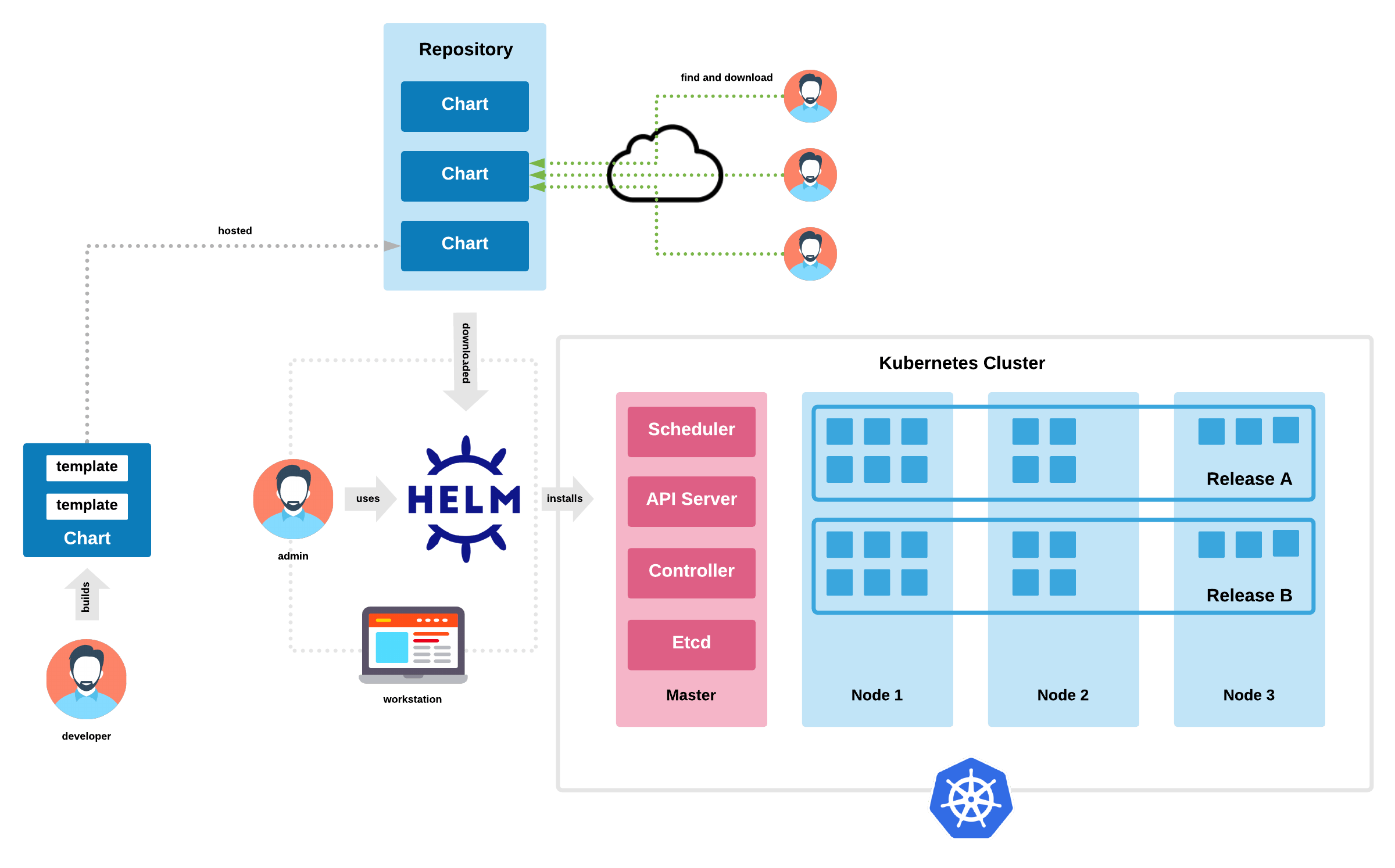What are Helm and Helmcharts?
Helm is the package manager tool for Kubernetes and it is a convenient way to package the Yaml files and distribute them to public and private repositories. for example, you have the application running on the cluster and you wanna deploy the Elastic stack for logging so, for this we need a couple of k8s components like config map, secret, stateful set, K8s user permission and services. It becomes tedious while doing it manually, wouldn't it be cool if there will some sort of way that we can bundle the configuration of all that k8s components and whenever needed deploy that bundled configuration and comes into the picture Helm charts.
A Helm chart is a collection of files that describe a specific application or service, along with its dependencies, and the necessary Kubernetes resources (such as deployments, services, and config maps) required to run the application on a Kubernetes cluster. A chart provides a declarative way to define, package, and deploy an application, abstracting away the complexities of managing individual Kubernetes resources manually.
What are the features of the helm?
Helm provides several key features that make it a powerful tool for managing applications on Kubernetes:
Package Management: Helm serves as a package manager for Kubernetes, allowing you to package applications and services into reusable charts. Charts encapsulate all the necessary resources and configurations, making it easy to distribute and deploy applications consistently.
Templating: Helm utilizes a powerful templating system that allows you to generate Kubernetes manifest files dynamically. Templates support variables, loops, conditionals, and other constructs, making it easy to customize configurations based on specific environments or user-defined values.
Release Management: Helm tracks installations as releases, allowing you to manage the lifecycle of deployed applications. You can upgrade, roll back, and uninstall releases using simple commands, ensuring consistent management of applications throughout their lifecycle.
Architecture of the Helm

On the client side, the Helm client is a command-line tool that runs on the user's local machine or client environment. It provides a user-friendly interface for interacting with the server-side components and executing Helm commands. The Helm client is responsible for tasks such as installing, upgrading, and managing charts, as well as communicating with the server-side components to perform these operations.
On the server side, the core components of Helm include the Kubernetes API server and the Kubernetes resources themselves. Helm interacts directly with the Kubernetes API server to manage the deployment, configuration, and tracking of releases.
In earlier versions of Helm (before Helm 3), there was an additional server-side component called Tiller. Tiller was responsible for managing releases and acted as an intermediary between the Helm client and the Kubernetes API server. However, starting from Helm 3, Tiller is no longer required, and Helm directly interacts with the Kubernetes API server, eliminating the need for an additional server-side component.
Structure of the helm charts
This has been taken from the helm official.
wordpress/ Chart.yaml # A YAML file containing information about the chart LICENSE # OPTIONAL: A plain text file containing the license for the chart README.md # OPTIONAL: A human-readable README file values.yaml # The default configuration values for this chart values.schema.json # OPTIONAL: A JSON Schema for imposing a structure on the values.yaml file charts/ # A directory containing any charts upon which this chart depends. crds/ # Custom Resource Definitions templates/ # A directory of templates that, when combined with values, # will generate valid Kubernetes manifest files. templates/NOTES.txt # OPTIONAL: A plain text file containing short usage notes
Important helm command
Here are some important Helm commands used in Kubernetes:
helm install: This command is used to install a chart onto a Kubernetes cluster. It deploys the specified chart and creates a new release.helm upgrade: This command is used to upgrade an existing release to a new version of a chart. It updates the deployed resources based on the changes in the new chart version.helm uninstall: This command is used to uninstall a release and remove all associated resources from the cluster.helm list: This command lists all the releases deployed on the cluster, showing their names, chart versions, and other relevant information.helm status: This command provides the status of a specific release, including information about deployed resources, version, and any other relevant details.helm rollback: This command rolls back a release to a previous version. It reverts the changes made during an upgrade and restores the previous state of the release.helm search: This command allows you to search for available charts in Helm repositories based on keywords or other criteria.helm repo adds: This command adds a new Helm repository to the local repository list. Helm repositories are used to host and distribute charts.helm repo update: This command updates the local repository cache, syncing it with the latest available charts and versions from the configured repositories.helm lint: This command checks the syntax and validity of a chart's files and provides feedback on any potential issues or errors.helm package: This command packages a chart directory into a compressed archive file (.tgz), which can then be distributed or installed using Helm.